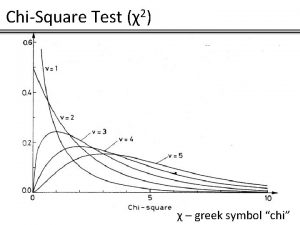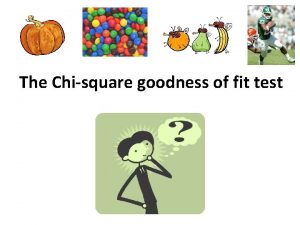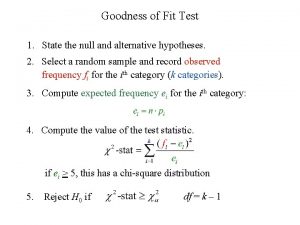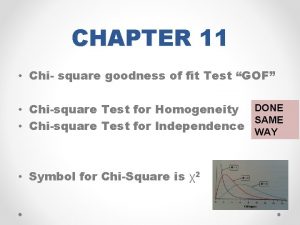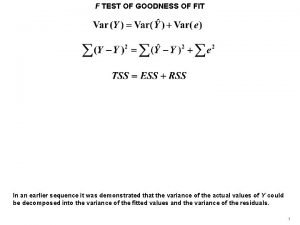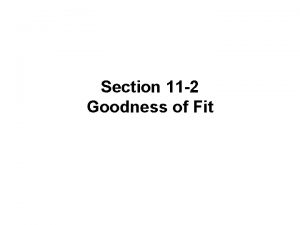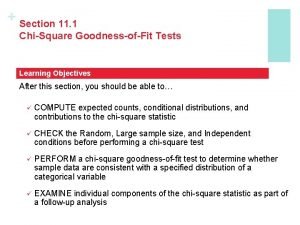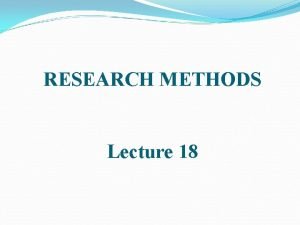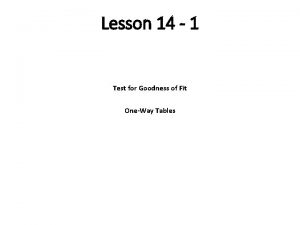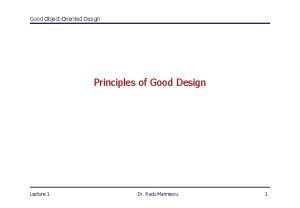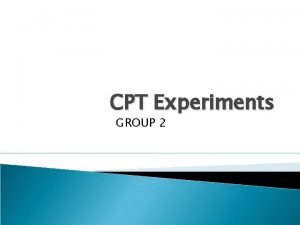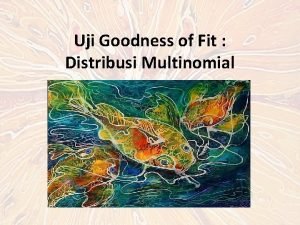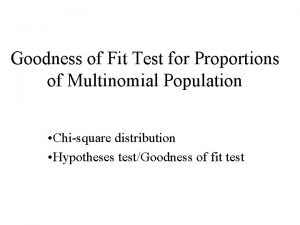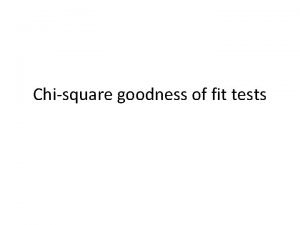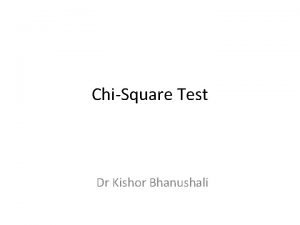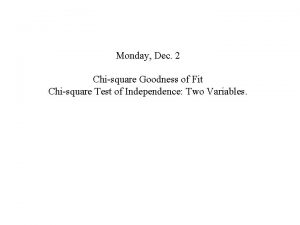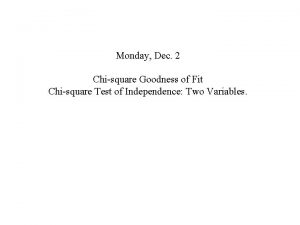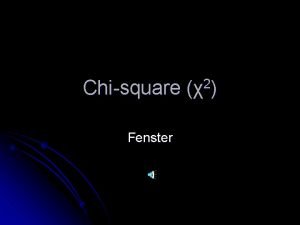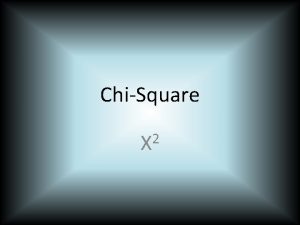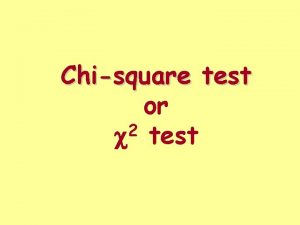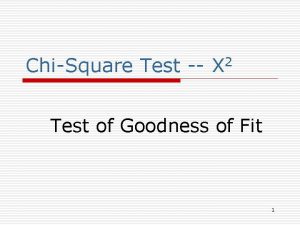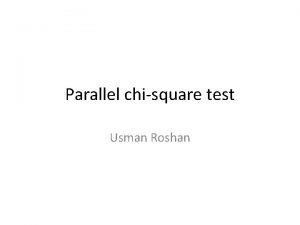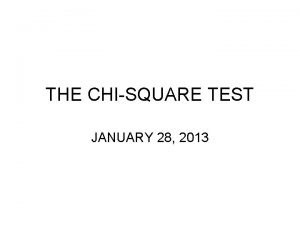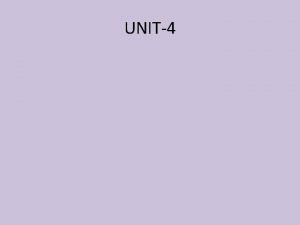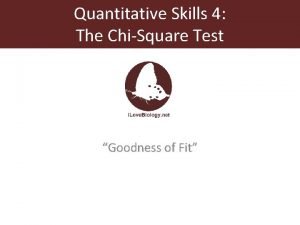ChiSquare Test 2 X Test of Goodness of
















- Slides: 16

Chi-Square Test -- 2 X Test of Goodness of Fit 1

(Pseudo) Random Numbers o o o Uniform: values conform to a uniform distribution Independent: probability of observing a particular value is independent of the previous values Should always test uniformity 2

Test for Independence o Autocorrelation Test n n Tests the correlation between successive numbers and compares to the expected correlation of zero e. g. 2 3 2 4 2 3 o n There is a correlation between 2 & 3 We won’t do this test o software available 3

Hypotheses & Significance Level o Null Hypotheses – Ho n n o Numbers are distributed uniformly Failure to reject Ho shows that evidence of non-uniformity has not been detected Level of Significance – α (alpha) n α = P(reject Ho|Ho is true) 4

Frequency Tests (Uniformity) o Kolmogorov-Smirnov n n o More powerful Can be applied to small samples Chi Square n n Large Sample size >50 or 100 Simpler test 5

Overview o o Not 100% accurate Formalizes the idea of comparing histograms to candidate probability functions Valid for large samples Valid for Discrete & Continuous 6

Chi-Square Steps - #1 o o Arrange the n observations into k classes Test Statistic: n n n o X 2 = Σ (i=0. . k) ( Oi – Ei)2 / Ei Oi = observed # in ith class Ei = expected # in ith class Approximates a X 2 distribution with (k-s-1) degrees of freedom 7

Degrees of Freedom o o o Approximates a X 2 distribution with (k-s-1) degrees of freedom s = # of parameters for the dist. Ho: RV X conforms to ? ? distribution with parameters ? ? H 1: RV X does not conform Critical value: X 2(alpha, dof) from table Ho reject if X 2 > X 2 (alpha, dof) 8

X 2 Rules o o Each Ei > 5 If discrete, each value should be separate group If group too small, can combine adjacent, then reduce dof by 1 Suggested values n n = 50, k = 5 – 10 n = 100, k = 10 – 20 n > 100, k = sqrt(n) – n/5 9

Degrees of Freedom o o k–s– 1 Normal: s=2 Exponential: s = 1 Uniform: s = 0 10

X 2 Example o o Ho: Ages of MSU students conform to a normal distribution with mean 25 and standard deviation 4. Calculate the expected % for 8 ranges of width 5 from the mean. 11

X 2 Example o Expected percentages & values n n n <10 -15 = 2. 5% 15 -20 = 13. 5% 20 -25 = 34% 25 -30 = 34% 30 -35 = 13. 5% 35 -40> = 2. 5% 5 27 68 68 27 5 12

X 2 Example o Consider 200 observations with the following results: n n n 10 -15 = 1 15 -19 = 70 20 -24 = 68 25 -29 = 41 30 -34 = 10 35 -40+ = 10 13

Graph of Data 70 60 50 40 30 20 10 15 20 25 30 35 14

X 2 Example o X 2 Values – (O-E)2/E n 10 -15 = 15 -20 = 20 -25 = 25 -30 = 30 -35 = 35 -40+ = n Total n n n (5 -1)2/5 (27 -70) 2/27 (68 -68) 2/68 (68 -41) 2/68 (27 -10) 2/27 (5 -10) 2/4 3. 2 68. 4 0 10. 7 5 98 15

X 2 Example o o o DOF = 6 -3 = 3 Alpha = 0. 05 X 2 table value = 7. 81 X 2 calculated = 98 Reject Hypothesis 16
 Chi square greek symbol
Chi square greek symbol Chi square test goodness of fit
Chi square test goodness of fit Goodness of fit test
Goodness of fit test Chi test for homogeneity
Chi test for homogeneity F-test formula
F-test formula Goodness of fit test ti 83
Goodness of fit test ti 83 Lord byron writing style
Lord byron writing style Casinos are required to verify that their games
Casinos are required to verify that their games Good measurement
Good measurement Skala stapel
Skala stapel Chi square goodness of fit p value
Chi square goodness of fit p value Ood goodness criteria
Ood goodness criteria Oh how great the goodness of our god
Oh how great the goodness of our god Experiments in goodness
Experiments in goodness Macam macam uji goodness of fit
Macam macam uji goodness of fit Multinomial goodness of fit
Multinomial goodness of fit Judge danforth quotes
Judge danforth quotes
